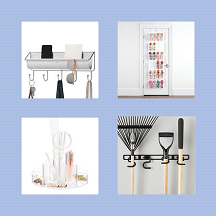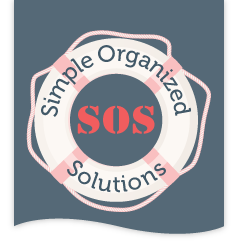 Containment is part of the organizing process. Containers make good storage solutions, but is it always easy to access the contents? This is a question that needs to be considered based on the type of storage solution. The criteria for storage may be different for each organizing solution, but ease of access should be a top priority.
Containment is part of the organizing process. Containers make good storage solutions, but is it always easy to access the contents? This is a question that needs to be considered based on the type of storage solution. The criteria for storage may be different for each organizing solution, but ease of access should be a top priority.
As mentioned in previous posts, containment, or containers come in all shapes and sizes. Every box, bin, basket, shelf, drawer, rack, cabinet, pantry, closet and room in your house is a container, as well as your house itself. How we organize these containers determines ease of access.
Most containers have lids. Some have hinges that are permanently attached. Others may have a lid that snaps on, that could be left off. Other containers, maybe a rack, basket, or a repurposed item, will not have a lid at all.
How you use the container, whether it has a lid or not, will determine how easy it is to access the contents. The concept for a good organizing solution should be mindful that you can find what you need, when you need it, and easy access for quick retrieval. If it’s cumbersome to get into a container to retrieve an item, you’re less likely to maintain this solution.
Obviously, open containers are easier to access their contents than closed containers. As you’re determining your containment needs, I encourage you to use open containers whenever possible to provide ease of access.
The list below provides scenarios and tips for how to use open containment for easy access. If you know of others not shown here, please share your thoughts in the comment box below.
- When stacking multiple containers that hold like items, such as inventory or overflow, remove the lid from the top container. You can easily access the contents. When that container is empty, replace the lid and move it to the bottom of the stack. Then remove the lid from the top container.
- Drawers – use drawer dividers for small objects such as empty checks boxes-yes, some people still write checks, jewelry boxes, or yogurt cups. If they have lids, remove them so you can easily access the contents of each container. Actual drawer dividers work well in the kitchen for utensils in various sizes.
- Racks & hooks – these are great for hanging just about anything in any room in, or outside your house. Kitchen utensils, brooms, pots & pans, jewelry, backpacks, totes, hand tools and garden tools are just some examples that are easy to access hanging from a rack or a hook. Various types of racks & hooks work very well for organizing a garage.
- Over-the-door storage – there are so many options for storage that hangs over a door. These products have shelves, hooks or pockets and come in a variety of materials. They can be used in any room that has a door, although a pocket door will not work. You can see the contents at a glance and pick out what you need quickly.
- Hanging files – this one is really a no-brainer. The hanging files have to be contained in a file cabinet or a tote, but either way, paperwork is easily accessible. How you organize paperwork in these files makes for a quick retrieval system.
- Organizing products – here is another no-brainer. There are so many organizing products on the market that provide easy access. They are designed that way intentionally. Many office products that hang on the wall, or sit on a desk are typically open with easy access in mind.


